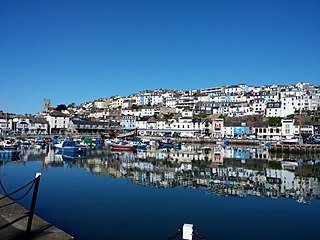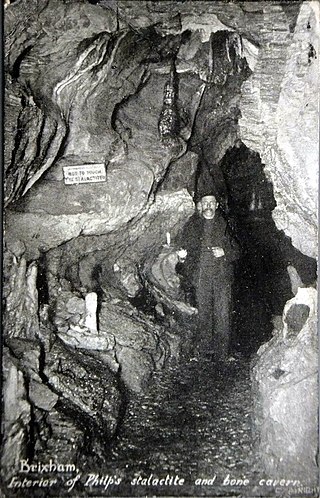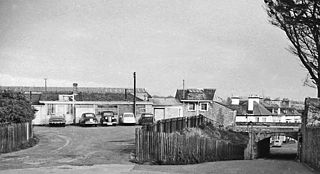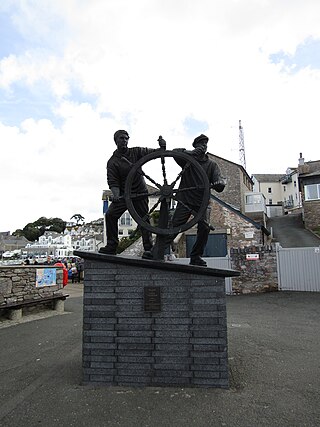
Torquay is a seaside town in Devon, England, part of the unitary authority area of Torbay. It lies 18 miles (29 km) south of the county town of Exeter and 28 miles (45 km) east-north-east of Plymouth, on the north of Tor Bay, adjoining the neighbouring town of Paignton on the west of the bay and across from the fishing port of Brixham.

Brixham is a coastal town and civil parish, the smallest and southernmost of the three main population centres on the coast of Torbay in the county of Devon, in the south-west of England. Commercial fishing and tourism are the two main industries. As of the 2021 census, Brixham had a population of 16,825.

Torbay is a borough and unitary authority in Devon, south west England. It is governed by Torbay Council and consists of 62.87 square kilometres (24.27 sq mi) of land, including the resort towns of Torquay, Paignton and Brixham, located on east-facing Tor Bay, part of Lyme Bay on the English Channel. A popular tourist destination, Torbay's sandy beaches, mild climate and recreational and leisure attractions have given rise to its nickname of the "English Riviera".

Paignton is a seaside town on the coast of Tor Bay in Devon, England. Together with Torquay and Brixham it forms the borough of Torbay which was created in 1998. The Torbay area is a holiday destination known as the English Riviera. Paignton's population in the United Kingdom Census of 2011 was 49,021. It has origins as a Celtic settlement and was first mentioned in 1086. It grew as a small fishing village and a new harbour was built in 1847. A railway line was opened to passengers in 1859 creating links to Torquay and London. As its population increased, it merged with the villages of Goodrington and Preston. Paignton is around 25 miles (40 km) north east of Plymouth and 20 miles (32 km) south of Exeter, and has the fourth largest population in Devon.

The Royal Exhibition Building is a World Heritage-listed building in Melbourne, Victoria, Australia, built in 1879–1880 as part of the international exhibition movement, which presented over 50 exhibitions between 1851 and 1915 around the globe. The building sits on approximately 26 hectares, is 150 metres (490 ft) long and is surrounded by four city streets. It is at 9 Nicholson Street in the Carlton Gardens, flanked by Victoria, Carlton and Rathdowne Streets, at the north-eastern edge of the central business district. It was built to host the Melbourne International Exhibition in 1880–81, and then hosted the even larger Centennial International Exhibition in 1888, and the formal opening of the first Parliament of Australia in 1901. The building is representative of the money and pride Victoria had in the 1870s. Throughout the 20th century smaller sections and wings of the building were subject to demolition and fire; however, the main building, known as the Great Hall, survived.

The Royal Air Force Museum London is located on the former Hendon Aerodrome. It includes five buildings and hangars showing the history of aviation and the Royal Air Force. It is part of the Royal Air Force Museum.

The River & Rowing Museum in Henley-on-Thames, Oxfordshire, England, is located on a site at Mill Meadows by the River Thames. It has three main themes represented by major permanent galleries, the non-tidal River Thames, the international sport of rowing and the local town of Henley-on-Thames.

Churston railway station is on the Dartmouth Steam Railway, a heritage railway in Torbay, Devon, England. It is situated beside the main road to Brixham and close to the villages of Churston Ferrers and Galmpton. There has been no scheduled service at the station since 2020.

Valence House Museum is the only surviving of the five manor houses of Dagenham. The timber-framed museum building, partially surrounded by a moat, is situated in Valence Park off Becontree Avenue, in the London Borough of Barking and Dagenham, London, England. The building has been used as a manor house, a family home, a town hall, the headquarters of the library service and now houses a museum.

Brighton Toy and Model Museum is an independent toy museum situated in Brighton, East Sussex. Its collection focuses on toys and models produced in the UK and Europe up until the mid-Twentieth Century, and occupies four thousand square feet of floor space within four of the early Victorian arches supporting the forecourt of Brighton railway station. Founded in 1991, the museum holds over ten thousand toys and models, including model train collections, puppets, Corgi, Dinky, Budgie Toys, construction toys and radio-controlled aircraft.

Abingdon County Hall Museum is a local museum in Abingdon, Oxfordshire, England. The museum is run by Abingdon Town Council and supported by Abingdon Museum Friends, a registered charity. It is a Grade II listed building.
The fishing industry in England covers the fish processing industry and fishing trawler companies that fish around England.

A Brixham trawler is a type of wooden, deep-sea fishing trawler first built in Brixham in Devon, England, in the 19th century and known for its high speed. The design was copied by boat builders around Britain, and some were sold to fishermen in other countries on the North Sea.
The Scarborough Maritime Heritage Centre (SMHC), is a museum situated in Scarborough, North Yorkshire, England, and opened on 12 December 2009. The centre reveals the town's maritime history to residents and visitors. Five years in the making, this "museum of the sea" has gathered a huge collection of photographs, historical documents and artefacts about Scarborough's and Yorkshire's coast maritime life.

Sharkham Point Iron Mine was an iron mine at Sharkham Point, near the town of Brixham in Devon. The mine was worked for around 125 years and employed at its peak 100 workers. It was primarily an open cast mine, but five shafts and six adits are also mentioned in reports of the site. Some are still accessible today, but since the area was used as a rubbish tip in the 1950s and 60s, much of the archaeology has been covered over.

Windmill Hill Cavern is a limestone cave system in the town of Brixham, Devon. It was discovered in 1858 and later excavated by a team led by the geologist William Pengelly, who found proof that humans co-existed with extinct British fauna.

Brixham railway station was a railway station on the Torbay and Brixham Line, serving the town of Brixham, in Devon. The station opened in 1868 and closed in 1963. The station was subsequently demolished and the site was developed as a housing estate.

A statue of William III, also known as the Prince of Orange statue, stands in Brixham, Devon, England. It commemorates the landing of William of Orange and his army at the town on 5 November 1688. The monument has been a Grade II listed building since 1949.

Man and Boy is a statue situated at King's Quay on the harbour of Brixham, Devon, England. It is the result of a long fundraising effort; the residents of the town raised £76,000 for its construction. The monument was created in clay by the local sculptor Elisabeth Hadley and cast in bronze in Shropshire.

Churston Woods is an area of semi-ancient woodland near the village of Churston Ferrers and the town of Brixham. The woodland is made up of two main sections called The Grove and Ball Copse, both of which are owned by Torbay Council and managed by Torbay Coast and Countryside Trust.



















